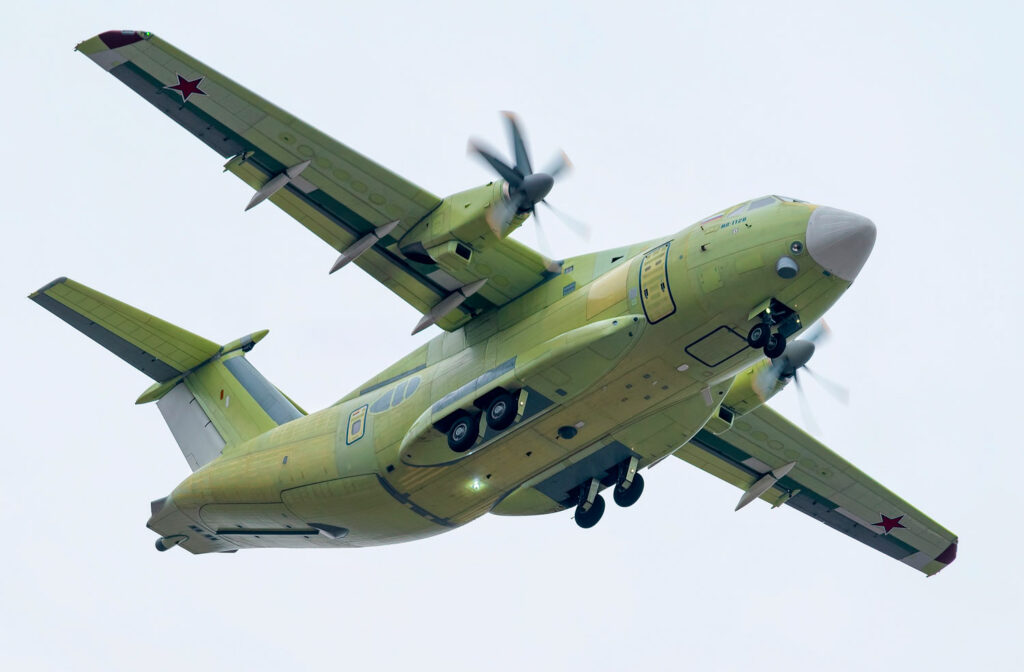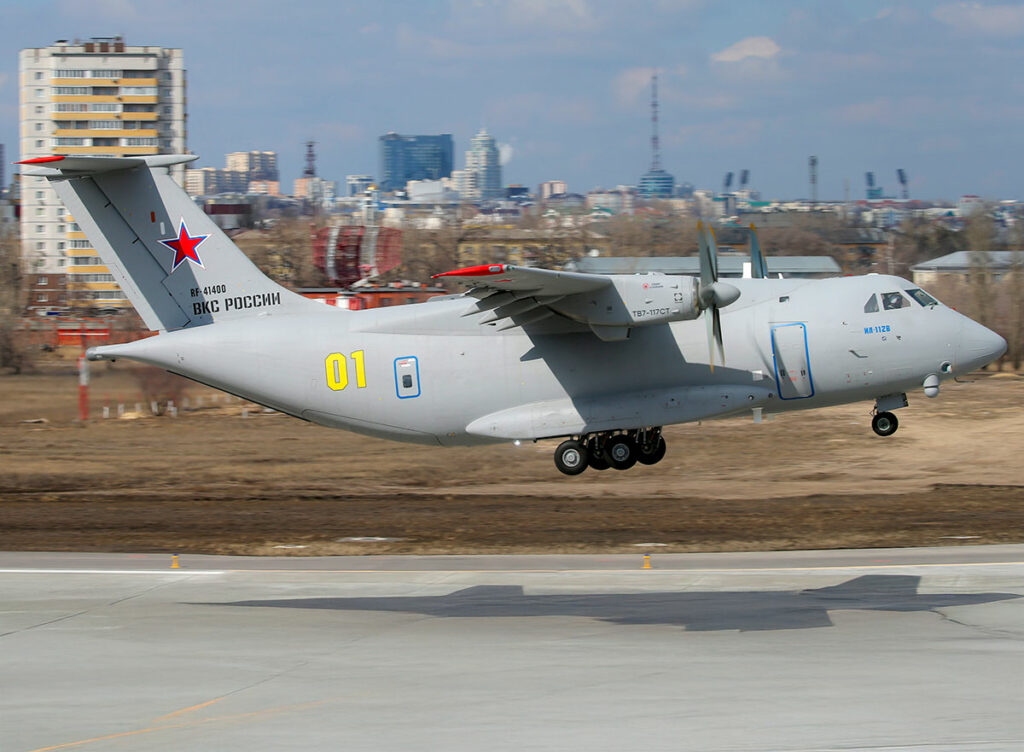The Ilyushin Il-112 is a Russian high-wing, twin-engine turboprop military transport aircraft designed for cargo and personnel transport, featuring advanced avionics and a 5-ton payload capacity.
The Ilyushin Il-112 is a light military transport aircraft developed by Russia’s Ilyushin Aviation Complex to replace the aging Antonov An-26 fleet. Designed for air landing and airdrop missions, it features a high-wing monoplane design with twin Klimov TV7-117ST turboprop engines, each producing 3,500 horsepower. The aircraft’s cargo hold accommodates up to 5 tons, including 44 armed soldiers or various military equipment. Modern avionics integrate flight and systems data across six LCD displays, reducing crew requirements to two. The Il-112 meets current ICAO noise and emission standards and is capable of operating in diverse weather conditions, day or night. Its maximum takeoff weight is approximately 44,000 pounds (20,000 kilograms), with a cruising speed around 295 miles per hour (475 kilometers per hour) and a service ceiling of 24,934 feet (7,600 meters). The aircraft’s range extends to 2,485 miles (4,000 kilometers) when carrying a 3.5-ton load.
History of Development
In the early 1990s, the Russian military identified the need to replace its aging fleet of Antonov An-26 transport aircraft, which had been in service since the 1960s. The An-26s were becoming increasingly outdated, lacking modern avionics, fuel efficiency, and compliance with evolving international noise and emission standards. To address these shortcomings, the Russian Ministry of Defense initiated a program to develop a new light military transport aircraft that would meet contemporary operational needs.
In 1994, Ilyushin Aviation Complex began work on the Il-112 project, envisioning both civil and military variants, including a 40-seat airliner and cargo versions with a rear loading ramp. The military transport version, designated Il-112V, was entered into a competition by the Russian Ministry of Defense to replace the An-26, Yakovlev Yak-40, and Let L-410 aircraft in Russian service. The Il-112V was evaluated against designs from Sukhoi and Mikoyan. On April 8, 2003, the Il-112 was ordered into full development, with plans to enter service in 2008. The aircraft was required to carry a cargo of 6,000 kilograms (13,227 pounds) over a distance of 3,000 kilometers (1,864 miles). At that time, the market potential was estimated at up to 120 aircraft for the Russian military and an additional 120 for civil sales.
However, by May 2010, with allocated funds exhausted and no prototype in sight, the Russian Ministry of Defense canceled the development contract. In May 2011, the ministry decided to purchase seven Antonov An-140T cargo aircraft produced by Aviakor in Samara, Russia, as an interim solution.
The project saw a revival in January 2013 when the Main Commander of the Russian Air Force presented a case to Defense Minister Sergei Shoigu for resuming the Il-112 project. By August 2013, work on the aircraft had officially resumed. A new contract was signed by Defense Minister Shoigu on November 14, 2014, with flight tests planned to begin in 2017 and production in 2019. The performance requirements were adjusted, with the aircraft now required to carry 5,000 kilograms (11,023 pounds) of cargo over a distance of 1,200 kilometers (746 miles).
The first prototype of the Il-112V was rolled out on November 27, 2018, intended for performance and flight handling trials. Taxi trials began by the end of December 2018. The aircraft performed its maiden flight on March 30, 2019. Following the initial flight, the prototype underwent modifications to reduce its weight by 800 kilograms (1,764 pounds), with further reductions planned for subsequent prototypes. Flight testing resumed on March 30, 2021.
Tragically, on August 17, 2021, the only flying prototype Il-112V (RF-41400) suffered a fire in the right engine and crashed near Kubinka Airfield, resulting in the loss of all three crew members on board. This incident led to a reevaluation of the project. In October 2023, it was reported that the Il-112 project would be redesigned and renamed the Ilyushin Il-212, with plans to equip the aircraft with turbofan engines instead of turboprops.

Design of the Ilyushin Il-112
The Ilyushin Il-112 features a high-wing monoplane design, a configuration that offers several advantages for military transport operations. The high-wing arrangement provides excellent ground clearance for engines and propellers, facilitating operations from unprepared or rough airstrips. It also allows for a spacious and unobstructed cargo hold, enhancing the aircraft’s utility in transporting various types of military equipment and personnel.
The fuselage of the Il-112 is designed with a circular cross-section, optimized to withstand heavy loads and to maximize internal volume. The cargo compartment measures approximately 8.4 meters (27.6 feet) in length, 2.45 meters (8 feet) in width, and 2.4 meters (7.9 feet) in height, providing enough space to accommodate 5,000 kilograms (11,023 pounds) of cargo. The rear ramp allows for quick loading and unloading of equipment, vehicles, and personnel, a critical feature for military logistics operations.
Aerodynamics and Structural Considerations
The aerodynamic profile of the Il-112 is optimized for efficiency at medium altitudes and subsonic speeds. The aircraft’s wingspan measures 27.6 meters (90.5 feet), and its wing area is 65 square meters (700 square feet). The high-mounted wing and T-tail configuration contribute to stability during takeoff, landing, and in turbulent conditions. The aircraft’s aluminum alloy construction is reinforced with composite materials, reducing overall weight while maintaining structural integrity.
One significant issue identified during early test flights was excessive weight, which required modifications to improve the aircraft’s overall payload-to-weight ratio. Engineers made adjustments, including reducing the tail section weight and optimizing the aircraft’s internal components to meet operational requirements.
Avionics and Flight Control Systems
The Il-112 incorporates modern avionics, integrating a glass cockpit with six multifunction LCD displays. The system is designed to provide pilots with comprehensive flight and systems data, reducing the need for multiple crew members. The fly-by-wire flight control system enhances aircraft handling and stability, particularly in adverse weather conditions.
The aircraft is equipped with a triple-redundant digital flight control system, ensuring high reliability and reducing pilot workload. The avionics suite includes GPS navigation, weather radar, and automatic dependent surveillance-broadcast (ADS-B) systems, allowing for improved situational awareness.
Propulsion System and Powerplant
The Il-112 is powered by two Klimov TV7-117ST turboprop engines, each delivering 3,500 shaft horsepower (2,610 kW). These engines are paired with six-bladed AV-112 composite propellers, which enhance fuel efficiency and thrust. The engines provide sufficient power for short takeoff and landing (STOL) operations, making the aircraft suitable for remote and austere airstrips.
One of the primary challenges with the TV7-117ST engines was heat management and reliability. The August 2021 crash was attributed to an in-flight fire in the right engine, leading to an urgent redesign of the powerplant and exhaust systems. Despite these setbacks, the engine remains a highly efficient choice for the class.
Landing Gear and Operational Capabilities
The tricycle landing gear configuration is reinforced to withstand rough-field operations. The main landing gear consists of two large wheels, designed to support heavy loads and minimize ground pressure. The nose gear is steerable, allowing for precise maneuvering on narrow runways. The aircraft’s low-pressure tires enable landings on unpaved surfaces, a requirement for tactical military transport operations.
Advantages and Drawbacks
The Il-112 offers several advantages over older aircraft like the Antonov An-26:
- Improved fuel efficiency due to modern engines
- Reduced crew workload with digital avionics
- Better noise and emissions compliance (meets ICAO standards)
- Increased payload capacity compared to legacy aircraft
However, the aircraft has faced significant drawbacks, including higher-than-expected weight, engine reliability concerns, and delays in development. These factors have impacted its competitiveness in both domestic and export markets.
Performance of the Ilyushin Il-112
The performance characteristics of the Il-112 were designed to align with modern military airlift needs, focusing on short-range transport and low-cost operations.
Engine Power and Performance
Each TV7-117ST turboprop engine produces 3,500 shp (2,610 kW), with an emergency power boost up to 3,800 shp (2,834 kW). These engines provide a power-to-weight ratio that is comparable to its Western counterpart, the Lockheed C-27J Spartan.
The fuel consumption rate is approximately 200-220 kg per hour per engine, making the aircraft cost-effective for short missions. However, this also limits its range, requiring refueling on longer transport missions.
Speed and Altitude
- Cruising speed: 295 mph (475 km/h)
- Maximum speed: 320 mph (515 km/h)
- Service ceiling: 24,934 feet (7,600 meters)
The Il-112 is not designed for high-speed operations, making it unsuitable for rapid deployment scenarios. Compared to the Alenia C-27J Spartan, which has a maximum speed of 362 mph (583 km/h), the Il-112 is slower and less maneuverable.
Range and Endurance
The aircraft has a maximum range of 2,485 miles (4,000 km) when carrying a light load, but when fully loaded with 5,000 kg (11,023 lb) of cargo, its range reduces to approximately 745 miles (1,200 km). This short range is one of its key limitations.
Takeoff and Landing Characteristics
- Takeoff distance: 1,148 meters (3,766 feet)
- Landing distance: 900 meters (2,953 feet)
- Short takeoff and landing (STOL) capable: Yes
These characteristics allow the Il-112 to operate from short and unpaved runways, making it useful for tactical airlift missions in conflict zones.
Variants of the Ilyushin Il-112
Il-112V
- Primary military transport variant
- Designed for cargo and troop transport
- Features a rear-loading ramp
- Main production model
Il-112T
- Civilian cargo transport variant
- Optimized for commercial freight operations
- Modified to meet ICAO civil aviation regulations
Due to the cancellation of the Il-112 program, no additional variants were produced.

Military Use and Combat History
The Il-112 was never used in active combat, as its development was terminated following the 2021 crash. However, it was intended to replace the Antonov An-26 in Russian service.
Intended Role in Military Operations
- Tactical transport for troops and equipment
- Airborne resupply missions in remote regions
- Medical evacuation (MEDEVAC) operations
- Paratrooper deployment using side doors
Comparison to Competing Aircraft
The Il-112 was designed to compete with:
- Alenia C-27J Spartan (Italy)
- CASA C-295 (Spain)
- Antonov An-140T (Ukraine)
All three rival aircraft offer better range and payload capacity than the Il-112, which ultimately contributed to its cancellation.
Export and Cancellation
The Russian Ministry of Defense originally planned to procure up to 100 Il-112 aircraft, but after the fatal 2021 crash, the program was discontinued. In October 2023, reports indicated that the aircraft would be redesigned as the Il-212, featuring turbofan engines for improved efficiency.
The Ilyushin Il-112 was developed to modernize Russia’s light military transport capabilities, but engineering challenges, weight issues, and a fatal crash resulted in its cancellation. The aircraft was underpowered compared to Western alternatives and had significant limitations in range and payload capacity. While it incorporated modern avionics and STOL capabilities, its technical shortcomings prevented it from entering widespread service. The Il-212 is expected to address these failures, but as of 2024, no replacement aircraft has been introduced.
Back to Transport planes.